
Wine Culture and Information since 2002 - Volume 22
 Wine Culture and Information since 2002 - Volume 22 |
|
Contrasts of Trento “Blanc de Blancs” and Oltrepò Pavese Metodo Classico Pinot NeroTwo Italian leading territories for the production of classic method sparkling wines compared with two opposing styles: one produced with Chardonnay only, the other with the glorious Pinot Noir. |
|
The world of classic method sparkling wines undeniably has a particular charm, evocative wines of class and elegance, probably like no other style. Originated from the magic which is created over time inside a bottle – the same one from which it will then be poured into the glass – classic method sparkling wines have a relatively recent history of a few centuries and were immediately capable of conquering the most refined enthusiasts and, in particular, the wealthy ones. If it is true that this style of sparkling wine reaches the pinnacle of class and elegance in France, so much so that it has become famous and appreciated throughout the world thanks to the magnificence of Champagne, it must however be noticed the technique of the refermentation in bottle was invented in Italy. In this sense are significant the books of Gerolamo Conforti and Francesco Scacchi, who describe the production of these wines long before the famous event with which the abbot Dom Pierre Pérignon began, at Hautvillers, the undisputed glory of Champagne bubbles. The same fate also happened to sparkling wines refermented in closed tank: a technique invented by the Italian Federico Martinotti, then taken up and revised by the French Eugène Charmat – who is often credited as the inventor of this technique – then further developed by the Italian Nereo Cavazzani. As for classic method sparkling wines, the long French tradition and excellence must be credited with having discovered the most suitable and representative grapes for refermentation in bottle, as well as the development and improvement of the technique. Chardonnay, Pinot Noir and Pinot Meunier have practically always represented the most used varieties for the production of classic method sparkling wines. To these – in Champagne – must be added Pinot Blanc, Arbane, Petit Meslier and Pinot Gris, today considered marginal. The tradition and excellence of classic method sparkling wines is no less in Italy, particularly in the north, where the most significant production areas are found, in particular Franciacorta, Trento, Oltrepò Pavese and Alta Langa. In this regard, it must be noted that the varieties used in these denominations are the same ones used in Champagne, however expressing their own character and clearly distinct from that of the famous land of France.
|
|
Before talking about Trento, the famous Denominazione d'Origine Controllata sparkling wine (Denomination of Controlled Origin, DOC) a clarification is necessary regarding the mention “Blanc de Blancs”. It should in fact be noted this definition is not provided for in the relative production disciplinary, therefore it is reported in quotation marks. According to the typical custom of sparkling wine production, “Blanc de Blancs” is defined as a white wine produced exclusively from white grapes. The definition contrasts with “Blanc de Noirs” which means a wine produced exclusively with red berried grapes, obviously vinified as white. In accordance with the Trento production disciplinary – which only provides for sparkling wines produced with the classic method – the permitted varieties are Chardonnay, Pinot Blanc, Pinot Noir and Pinot Meunier. In our tasting by contrast, therefore, we mean a Trento exclusively produced with the allowed white grapes, more precisely, with Chardonnay alone. Trento's sparkling wine tradition is among the oldest and most consolidated in Italy, gaining over time a well-deserved position of absolute importance in the Italian and global wine scene. The sparkling wines of the Denominazione d'Origine Controllata Trento – also known as Trentodoc – owe their success both to the long sparkling wine tradition and, and above all, to the strong vocation of the territory, not least, the soil, weather and environment conditions. As for production, the disciplinary provides for a minimum time of refermentation in bottle for 15 months, a period increased to at least 24 for vintage sparkling wines, 36 for reserve wines. Trento's sparkling wine production also enjoys the important stylistic contribution that each producer successfully manages to impart to their wines, while maintaining a recognizable character that is generally found in all the wines of the denomination.
|
||||
|
Oltrepò Pavese is one of the main wine-growing areas of Lombardy, with a decidedly varied production of styles and wines, not least, with an impressive diversity and variety of cultivated grapes. It is one of the largest wine-growing areas in the region, classified as a Denominazione d'Origine Controllata (Denomination of Controlled Origin, DOC) and, within it, other denominations are also defined. Here it is also found Oltrepò Pavese Metodo Classico which – unlike the other denominations – is classified as Denominazione d'Origine Controllata e Garantita (Denomination of Controlled and Guaranteed Origin, DOCG). The main variety for the production of its wines is Pinot Noir which, according to the production disciplinary, must be present for a minimum quota of 70%. The possible complementary part may be composed of Chardonnay, Pinot Gris and Pinot Blanc. The production disciplinary also defines Oltrepò Pavese Metodo Classico Pinot Noir, in which the famous red berried grape from Burgundy must be present for at least 85%. The bond between Oltrepò Pavese and Pinot Noir is decidedly significant, here is in fact recorded one of the highest levels of presence among the denominations' vineyards in Italy. With this variety, in fact, in Oltrepò Pavese are produced five different styles: red, rosé, slightly sparkling, sparkling and white, the latter – of course – produced with the vinification in white technique, therefore with the immediate separation of the skins from the must. In this regard, it is worth noting that Pinot Noir vinified in red is reserved to a specific denomination: Oltrepò Pavese Pinot Nero. The history of classic method sparkling wines has seen, over time, the creation of many definitions and names, and finally to the definition of current Denominazione d'Origine Controllata e Garantita, DOCG, providing for the white and rosé styles. Although the disciplinary of Oltrepò Pavese Metodo Classico Pinot Nero provides for the minimum use of the grape of the same name for 85%, it must be noted that the majority of producers prefer the exclusive use of the famous red grape from Burgundy.
|
This month's tasting by contrast mainly focuses on the sensorial qualities of classic method sparkling wines exclusively produced with white and red grapes. In particular, we will pour into our glasses a classic method sparkling wine exclusively produced with Chardonnay and another with Pinot Noir. The bottles to be examined come respectively from the Trento and Oltrepò Pavese Metodo Classico denominations, in both cases with a low dosage of sugars, non-vintage and the base wine exclusively vinified in steel tanks. In the first case, therefore, we will choose a Trento Extra Brut exclusively produced with Chardonnay and – as already said – non-vintage. In the second case, we will choose an Oltrepò Pavese Metodo Classico Pinot Nero Extra Brut, vinified in white and non-vintage. When choosing the bottle we will pay attention to its composition, because, in accordance with its production disciplinary, Pinot Noir must be present for at least 85%, we will therefore make sure that it is exclusively produced with the red grape from Burgundy. The two sparkling wines are poured into tasting glasses at a temperature of 10 °C (50 °F). We can begin this month's tasting by contrast, so let's pour the two sparkling wines into their respective glasses, proceeding with the evaluation of their appearance, that is, how they present themselves to the eye in terms of color, transparency and perlage. The first wine we are going to examine is Trento Extra Brut, we therefore evaluate the development of its bubbles by observing the glass from the side, from the bottom towards the surface, then the “crown” by observing the wine from above. The color of this sparkling wine is bright straw yellow with very high transparency. The nuance, observed by tilting the glass and evaluating the wine towards the opening, confirms the same color. Let's move on to the evaluation of the Oltrepò Pavese Metodo Classico Pinot Nero and, just like for the previous wine, we evaluate the development of the bubbles, an examination which – in the specific case of this tasting – we can consider purely as a formal exercise for the style of wine, however not very significant for the purposes of the comparison. The color is intense straw yellow, darker than the previous sparkling wine, sometimes with golden yellow nuances. In general terms, the white classic method sparkling wines produced by Pinot Noir – and depending on the production and aging technique – have a more intense and darker color than those produced with Chardonnay. The olfactory profiles of classic method sparkling wines produced with Chardonnay and Pinot Noir reveal notable differences to the nose, having as a common factor – although with more or less different characters – the sensorial character given by the yeasts and their degradation. Classic method sparkling wines produced with Chardonnay express aromas on the nose that recall white pulp fruits, in particular banana, pear, apple and plum, as well as citrus fruits, such as grapefruit, citron and bergamot. To the nose are often also perceived aromas of tropical fruit and, in addition to the aforementioned banana, pineapple, passion fruit and lychee. The world of flowers is mainly represented by acacia, as well as hawthorn, broom, honeysuckle, linden and lily. The olfactory profile of classic method sparkling wines produced with 100% Pinot Noir is very different. On the nose there are clear aromas of apple, plum and pear, as well as cherry, raspberry, blueberry and tangerine, frequently pink grapefruit. The world of flowers is generally represented by hawthorn, cyclamen and dog rose, sometimes jasmine as well. Let's continue this month's tasting by contrast with the analysis of the olfactory profiles of Trento Extra Brut and Oltrepò Pavese Metodo Classico Pinot Nero Extra Brut, starting – as in the previous phase – from the wine produced with Chardonnay. By holding the glass in vertical position and without swirling, let's proceed with the first smell in order to evaluate the opening. On the nose there are intense and clean aromas of banana, apple and acacia, a rather frequent opening in all wines produced with Chardonnay. After swirling the glass, in order to favor the development of the remaining aromas, the olfactory profile of Trento Extra Brut is completed with pear, plum, grapefruit, pineapple, honeysuckle and linden. Let's now pass to the evaluation of the opening of the Oltrepò Pavese Metodo Classico Pinot Nero, proceeding with the first smell, without swirling the glass. On the nose can be perceived intense and clean aromas of apple, plum and cherry as well as the floral sensation of hawthorn. Let's now swirl the glass and proceed with the second smell: the profile of the wine is completed with raspberry, strawberry, tangerine, blueberry and pink grapefruit, as well as the floral aromas of cyclamen and dog rose. In both wines can also be clearly perceived the typical aromas of the long refermentation in bottle. Let's move on to the evaluation of the gustatory profiles of our classic method sparkling wines, starting – also in this case – from Trento Extra Brut. Let's take a sip of this wine and evaluate its attack, that is, the primary and identifying sensations of the taste. As easily predictable, the first sensation perceived in the mouth is the effervescence given by the carbon dioxide, promptly supported by the marked crispness of the acidity. However, the wine gets an excellent balance thanks to the effect of the alcohol and roundness, both of Chardonnay and of the aging in bottle on its own lees. The structure is good while expressing a marked elegance and finesse, with flavors that are directly reminiscent of banana, apple and pear. Let's now move on to the evaluation of the gustatory profile of the Oltrepò Pavese Metodo Classico Pinot Nero, also in this case in the Extra Brut style. In the mouth we immediately perceive the good effervescence and the intense crispness given by the acidity – definitely dry – also in this case well balanced both by the alcohol and by roundness given by the aging in bottle on its lees. The structure is fuller than the previous wine however with a lower roundness, with flavors of cherry, apple, plum, raspberry and tangerine. We have reached the end of this month's tasting by contrast, we therefore proceed with the evaluation of the final sensations the two wines leave in the mouth after swallowing, in particular, the taste-olfactory persistence, a primary factor of quality. The finish of Trento Extra Brut is persistent, leaving a sensation of crispness and a pleasing smooth roundness in the mouth, in addition to the flavors of banana, apple, pear and grapefruit. We can also continue to perceive the good sensation of structure and a distinctly elegant finesse. The finish of the Oltrepò Pavese Metodo Classico Pinot Nero is equally persistent, also in this case there is a clear sensation of crispness and good roundness in the mouth, although less round than the previous wine. The sensation of structure continues to be more intense than Trento Extra Brut and flavors of apple, plum, cherry, raspberry and mandarin are clearly perceived in the mouth. Before ending the tasting, let's proceed with a final smell of the two wines, first the Chardonnay and then the Pinot Noir. Note the clear difference in the olfactory qualities, decidedly distant although elegant in both cases.
|
||||||||
Wines of the Month |
|
|
|
Score legend Prices are to be considered as indicative. Prices may vary according to the country or the shop where wines are bought |

|
|
Dogliani Superiore San Bernardo 2018 |
|
| Anna Maria Abbona (Piedmont, Italy) | |
 Dolcetto Dolcetto | |
| Price: € 24.00 | Score: |
 Deep ruby red and nuances of ruby red, little transparency. Deep ruby red and nuances of ruby red, little transparency. Intense, clean, pleasing, refined and elegant, starts with hints of
cherry, plum and dried violet followed by aromas of blueberry, raspberry,
strawberry, blackberry, carob, chocolate, coffee, tobacco, rosemary,
almond, vanilla and menthol. Intense, clean, pleasing, refined and elegant, starts with hints of
cherry, plum and dried violet followed by aromas of blueberry, raspberry,
strawberry, blackberry, carob, chocolate, coffee, tobacco, rosemary,
almond, vanilla and menthol.
 Properly tannic attack and however balanced by alcohol, good body,
intense flavors, agreeable. Properly tannic attack and however balanced by alcohol, good body,
intense flavors, agreeable.
 Persistent finish with flavors of cherry, plum and blueberry. Persistent finish with flavors of cherry, plum and blueberry. Aged in cask. Aged in cask. |
|
 Stuffed pasta with meat and mushrooms, Roasted meat, Broiled meat and barbecue, Stewed meat with mushrooms, Hard cheese Stuffed pasta with meat and mushrooms, Roasted meat, Broiled meat and barbecue, Stewed meat with mushrooms, Hard cheese |
|

|
|
Barolo del Comune di Castiglione Falletto 2018 |
|
| Anna Maria Abbona (Piedmont, Italy) | |
 Nebbiolo Nebbiolo | |
| Price: € 40.00 | Score: |
 Brilliant ruby red and nuances of brick red, moderate transparency. Brilliant ruby red and nuances of brick red, moderate transparency. Intense, clean, pleasing, refined and elegant, starts with hints of
cherry, plum and dried violet followed by aromas of dried rose, strawberry,
raspberry, chocolate, cinnamon, tobacco, mace, licorice, leather, thyme,
vanilla and menthol. Intense, clean, pleasing, refined and elegant, starts with hints of
cherry, plum and dried violet followed by aromas of dried rose, strawberry,
raspberry, chocolate, cinnamon, tobacco, mace, licorice, leather, thyme,
vanilla and menthol.
 Tannic attack and however balanced by alcohol, full body, intense
flavors, pleasing crispness. Tannic attack and however balanced by alcohol, full body, intense
flavors, pleasing crispness.
 Very persistent finish with long flavors of cherry, plum and raspberry. Very persistent finish with long flavors of cherry, plum and raspberry. Aged in cask. Aged in cask. |
|
 Game, Roasted meat, Braised and stewed meat with mushrooms, Hard cheese Game, Roasted meat, Braised and stewed meat with mushrooms, Hard cheese |
|
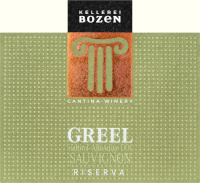
|
|
Alto Adige Sauvignon Riserva Greel 2020 |
|
| Cantina Produttori Bolzano (Alto Adige, Italy) | |
 Sauvignon Blanc Sauvignon Blanc | |
| Price: € 28.00 | Score: |
 Intense greenish yellow and nuances of greenish yellow, very
transparent. Intense greenish yellow and nuances of greenish yellow, very
transparent.
 Intense, clean, pleasing, refined and elegant, starts with hints of
gooseberry, peach and elder flower followed by aromas of acacia, broom,
nettle, grapefruit, apple, pear, pineapple, mango, tomato leaf, flint and
hints of vanilla. Intense, clean, pleasing, refined and elegant, starts with hints of
gooseberry, peach and elder flower followed by aromas of acacia, broom,
nettle, grapefruit, apple, pear, pineapple, mango, tomato leaf, flint and
hints of vanilla.
 Crisp attack and however balanced by alcohol, good body, intense
flavors, agreeable. Crisp attack and however balanced by alcohol, good body, intense
flavors, agreeable.
 Very persistent finish with long flavors of gooseberry, peach and
grapefruit. Very persistent finish with long flavors of gooseberry, peach and
grapefruit.
 Fermented and aged in cask and barrique. Fermented and aged in cask and barrique. |
|
 Stuffed pasta with fish and mushrooms, Roasted fish, Broiled fish, Stewed white meat, Dairy products Stuffed pasta with fish and mushrooms, Roasted fish, Broiled fish, Stewed white meat, Dairy products |
|
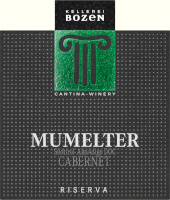
|
|
Alto Adige Cabernet Riserva Mumelter 2019 |
|
| Cantina Produttori Bolzano (Alto Adige, Italy) | |
 Cabernet Sauvignon (90%), Cabernet Franc (10%) Cabernet Sauvignon (90%), Cabernet Franc (10%) | |
| Price: € 38.00 | Score: |
 Deep ruby red and nuances of garnet red, little transparency. Deep ruby red and nuances of garnet red, little transparency. Intense, clean, pleasing, refined and elegant, starts with hints of
black currant, black cherry and violet followed by aromas of iris, plum,
blueberry, blackberry, cocoa, tobacco, leather, cigar box, licorice, black
pepper, vanilla and eucalyptus. Intense, clean, pleasing, refined and elegant, starts with hints of
black currant, black cherry and violet followed by aromas of iris, plum,
blueberry, blackberry, cocoa, tobacco, leather, cigar box, licorice, black
pepper, vanilla and eucalyptus.
 Properly tannic attack and however balanced by alcohol, full body,
intense flavors, pleasing roundness. Properly tannic attack and however balanced by alcohol, full body,
intense flavors, pleasing roundness.
 Very persistent finish with long flavors of black currant, black cherry
and plum. Very persistent finish with long flavors of black currant, black cherry
and plum.
 12 months in barrique and cask. 12 months in barrique and cask. |
|
 Game, Roasted meat, Braised and stewed meat, Hard cheese Game, Roasted meat, Braised and stewed meat, Hard cheese |
|
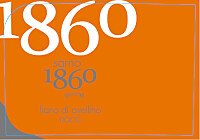
|
|
Fiano di Avellino Emme 2020 |
|
| Tenuta Sarno 1860 (Campania, Italy) | |
 Fiano Fiano | |
| Price: € 20.00 | Score: |
 Pale straw yellow and nuances of greenish yellow, very transparent. Pale straw yellow and nuances of greenish yellow, very transparent. Intense, clean, pleasing and refined, starts with hints of apple, pear
and hawthorn followed by aromas of broom, jasmine, peach, citrus fruits,
pineapple, white melon, plum, hazelnut and flint. Intense, clean, pleasing and refined, starts with hints of apple, pear
and hawthorn followed by aromas of broom, jasmine, peach, citrus fruits,
pineapple, white melon, plum, hazelnut and flint.
 Crisp attack and however balanced by alcohol, good body, intense
flavors, agreeable. Crisp attack and however balanced by alcohol, good body, intense
flavors, agreeable.
 Persistent finish with flavors of apple, pear and hazelnut. Persistent finish with flavors of apple, pear and hazelnut. 12 months in steel tanks, 6 months in bottle. 12 months in steel tanks, 6 months in bottle. |
|
 Pasta with fish, Fried fish, Sauteed white meat, Stewed fish, Dairy products Pasta with fish, Fried fish, Sauteed white meat, Stewed fish, Dairy products |
|
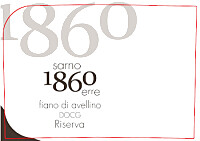
|
|
Fiano di Avellino Riserva Erre 2020 |
|
| Tenuta Sarno 1860 (Campania, Italy) | |
 Fiano Fiano | |
| Price: € 22.00 | Score: |
 Brilliant straw yellow and nuances of straw yellow, very transparent. Brilliant straw yellow and nuances of straw yellow, very transparent. Intense, clean, pleasing, refined and elegant, starts with hints if
apple, pear and plum followed by aromas of hawthorn, broom, pineapple,
grapefruit, peach, hazelnut, linden, beeswax, rosemary, mint and mineral. Intense, clean, pleasing, refined and elegant, starts with hints if
apple, pear and plum followed by aromas of hawthorn, broom, pineapple,
grapefruit, peach, hazelnut, linden, beeswax, rosemary, mint and mineral.
 Crisp attack and however balanced by alcohol, good body, intense
flavors, agreeable. Crisp attack and however balanced by alcohol, good body, intense
flavors, agreeable.
 Very persistent finish with long flavors of apple, plum and hazelnut. Very persistent finish with long flavors of apple, plum and hazelnut. 26 months in steel tanks, 3 months in bottle. 26 months in steel tanks, 3 months in bottle. |
|
 Stuffed pasta with fish, Roasted white meat, Roasted fish, Stewed fish with mushrooms Stuffed pasta with fish, Roasted white meat, Roasted fish, Stewed fish with mushrooms |
|
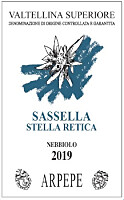
|
|
Valtellina Superiore Sassella Stella Retica 2019 |
|
| Arpepe (Lombardy, Italy) | |
 Nebbiolo Nebbiolo | |
| Price: € 35.00 | Score: |
 Brilliant ruby red and nuances of garnet red, moderate transparency. Brilliant ruby red and nuances of garnet red, moderate transparency. Intense, clean, pleasing, refined and elegant, starts with hints of
cherry, plum and dried violet followed by aromas of dried rose, raspberry,
strawberry, cinnamon, chocolate, tobacco, leather, thyme, rosemary,
licorice, vanilla and menthol. Intense, clean, pleasing, refined and elegant, starts with hints of
cherry, plum and dried violet followed by aromas of dried rose, raspberry,
strawberry, cinnamon, chocolate, tobacco, leather, thyme, rosemary,
licorice, vanilla and menthol.
 Properly tannic attack and however balanced by alcohol, full body,
intense flavors, pleasing crispness. Properly tannic attack and however balanced by alcohol, full body,
intense flavors, pleasing crispness.
 Very persistent finish with long flavors of cherry, plum and raspberry. Very persistent finish with long flavors of cherry, plum and raspberry. 15 months in cask and cement tanks. 15 months in cask and cement tanks. |
|
 Game, Roasted meat, Stewed and braised meat with mushrooms, Cheese Game, Roasted meat, Stewed and braised meat with mushrooms, Cheese |
|
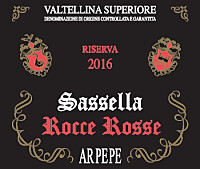
|
|
Valtellina Superiore Sassella Riserva Rocce Rosse 2016 |
|
| Arpepe (Lombardy, Italy) | |
 Nebbiolo Nebbiolo | |
| Price: € 70.00 | Score: |
 Brilliant garnet red and nuances of brick red, moderate transparency. Brilliant garnet red and nuances of brick red, moderate transparency. Intense, clean, pleasing, refined and elegant, starts with hints of
cherry, plum and dried rose followed by aromas of dried violet, raspberry,
strawberry, cocoa, cinnamon, tobacco, clove, leather, licorice, mace,
vanilla and menthol. Intense, clean, pleasing, refined and elegant, starts with hints of
cherry, plum and dried rose followed by aromas of dried violet, raspberry,
strawberry, cocoa, cinnamon, tobacco, clove, leather, licorice, mace,
vanilla and menthol.
 Properly tannic attack and however balanced by alcohol, full body,
intense flavors, pleasing crispness. Properly tannic attack and however balanced by alcohol, full body,
intense flavors, pleasing crispness.
 Very persistent finish with long flavors of cherry, plum and
raspberry. Very persistent finish with long flavors of cherry, plum and
raspberry.
 34 months in cask and cement tanks. 34 months in cask and cement tanks. |
|
 Game, Roasted meat, Braised and stewed meat, Hard cheese Game, Roasted meat, Braised and stewed meat, Hard cheese |
|
|
||||||||
|
DiWineTaste Polls
|
| |||||||
Privacy Policy | |||||||


| Copyright © 2002-2024 Antonello Biancalana, DiWineTaste - All rights reserved |
| All rights reserved under international copyright conventions. No part of this publication and of this WEB site may be
reproduced or utilized in any form or by any means, electronic or mechanical, without permission in writing from DiWineTaste. |